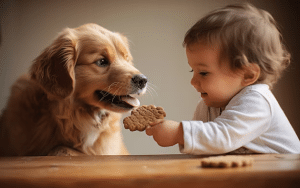Behavioral puppy training: Dogs react differently to their owner’s absence; there may be one symptom or several. Often, the pet senses the person leaving and, long before this, begins to show anxiety.
The following symptoms of stress are likely: following, trembling, whining, or aggression when a person tries to leave the house. So, let’s learn more about behavioral puppy training.
Absolutely! Let’s break down behavioral puppy training with a specific focus on separation anxiety and jumping:
Behavioral Puppy Training: Understanding the Why
- Separation Anxiety: Dogs are social creatures, and some develop intense anxiety when left alone. This isn’t bad behavior – it’s genuine distress. Signs include barking, howling, destructive chewing, whining, pacing, and even accidents in the house.
- Jumping: While often a sign of excitement, jumping on people can be annoying or dangerous for the humans involved. It’s important to redirect this energy into more appropriate greetings.
Key Principles:
- Roots of Behavior: Training is most effective when you address the underlying reason for the behavior, not just punish the symptom.
- Gradual Change: Puppies learn best with small, incremental changes in their routine. Trying to force them to be alone for hours or completely ignoring them when they jump will backfire.
- Positive Reinforcement: Focus on rewarding calm, appropriate behavior rather than punishing the unwanted ones.
Separation Anxiety Solutions
- Desensitization: Start by leaving your puppy alone in a safe space (crate, playpen) for VERY short periods, like 1-2 minutes. Reward extensively for calm behavior. Slowly increase the time alone.
- Counterconditioning: Create positive associations with being alone. Leave puzzle toys filled with treats, calming music, or a worn shirt that smells like you as a comfort.
- Tire Them Out: A good walk or play session before being left alone can help your puppy settle more easily.
- Avoid Big Farewells: Keep your departures and arrivals low-key to minimize the puppy’s anxiety buildup.
Stopping the Jumps
- Ignore & Redirect: When your puppy jumps, turn away and give no attention whatsoever. When they have all four paws on the ground, reward them with attention, praise, or a treat.
- Teach an Alternative: Teach commands like “sit” or “down.” Dogs cannot jump and sit at the same time! Reward them for these behaviors instead when greeting people.
- Controlled Greetings: If your pup tends to jump on guests, keep them on a leash for greetings. Reward calm behavior; if they jump, gently guide them away and make them sit before they get any attention.
Additional Tips
- Puppy’s Age: The younger, the better! Habits are easier to change before they become ingrained.
- Consistency is Everything: Everyone interacting with your puppy must follow the same training rules, or your puppy will need clarification.
- Patience & Kindness: Training takes time. Set realistic expectations and focus on positive progress, not perfection.
Key Takeaway
Puppy behavioral training is an investment in a happy, well-adjusted dog. It’s about understanding your puppy’s needs and teaching them how to navigate the world in a safe and enjoyable way for everyone.
Behavior Analysis Of Dog:
Before you solve the problem, it is necessary to analyze the dog’s behavior and relationship with the owner. Animals strongly oriented toward humans constantly follow on their heels, throwing themselves at their feet and rushing to perch on their knees or stomach stomachs at every opportunity. Pets without behavioral disorders show independence. During games and walks, they prefer fun with their fellow creatures to communicating with humans.
Why does a dog act restless when left alone at home?
To answer this question, first, we must remember that a dog is a descendant of wild animals that spend their entire lives in the wild.
Even in a small and seemingly completely harmless dog, the genes of its wild ancestor, the wolf, can awaken occasionally. In this case, locked within four walls, especially for a long time, the dog may think it is in a closed, limited space as a punishment since it cannot get out of there alone.
Young individuals are especially susceptible to this behavior; more experienced animals already know that a closed apartment door is not so much a trap as it ensures the absolute safety of the animal.
Sometimes, a dog’s reluctance to remain alone for a long time is explained by improper upbringing on the owner’s part.
If the owner locked his dog in a closed room as a punishment for some offense, it would be natural that the dog would not want to remain alone in a closed apartment – after all, this would cause unpleasant associations for the animal.
People with dogs must understand that regular daily walks are vital for these animals. If the dog is rarely or irregularly walked, being alone for a long time, it will begin to worry because a long absence from the owner will again mean that there will be no walks.
How do you train a puppy to be alone at home?
Leave the dog alone in the room. For proper behavior, that is, when she sits quietly, you need to come and praise her. If the puppy begins to worry, you should also go in there but ignore him. The period of loneliness gradually increases – from a few seconds to 20-30 minutes.
The previous actions are repeated with the condition that the owner must leave the apartment. For example, you can stay on the staircase, listening at the door to what is happening in the room.
Leave the house completely, for example, to the store or for a short walk. In this case, you can leave the puppy toys or a healthy treat.
The steps are repeated until the desired result is achieved. Calculate how long your pet can be alone in the house to make the learning process easier. To do this, you need to add one to the animal’s age. So, if he is 2-3 months old, he will be able to withstand loneliness for 3-4 hours.
How do you stop a dog from barking or howling?
If, despite all your efforts, you find out that your puppy is howling or barking in your absence, you will have to take immediate action.
Improve the soundproofing of the room where the puppy stays. If the audibility is too good, the puppy begins to bark at every rustle.
Walk your puppy vigorously before leaving; a tired puppy will sleep soundly. Take a ball with you for a walk and actively run your puppy. 20-30 minutes of active running is quite enough.
If this does not help, then use an anti-bark collar. On sale, there are not only collars with an electric shock effect on a dog; there are models that respond to barking with a stream of air with the aroma of lemon, an ultrasonic signal, or a vibration effect.
If you are an active opponent of using electronic devices to raise dogs, you only have to get your puppy a buddy.
Another puppy or kitten will brighten up your absence and provide company for play. Please don’t forget that two puppies are difficult, especially if this is your first dog, but everything can be solved.
How can a dog stop jumping on people?
It would help if you started raising a dog as early as possible: even a three- or four-month-old puppy can understand what you want from him. But when raising a puppy, you should not use physical force. It is important to carefully and unobtrusively let him know exactly what not to do. Follow these simple tips:
When you come home, the puppy will probably try to lean on you with his front paws or jump up. It is important to prevent this from happening. Get down on your knees and let the dog sniff or even lick you. Pet the puppy, sit him down, and praise him;
An older puppy can be taken to the side and seated nearby, preventing attempts to jump on the owner.
If you are experiencing behavior problems in your dog, try the following method. As soon as your pet tries to jump on you, clearly command “Ugh!” and lift your knee towards your chest. The dog will not be able to lean his elbows and will rest on his leg.
It is important to show confidence in your actions and persistence; this movement should be repeated every time the pet makes another attempt to jump on you. Be patient because adolescence is the most difficult age to train.
Conclusion:
Providing a comfortable and safe place for your dog is one of the most important aspects of pet comfort. Proper arrangement of its space will help create a favorable environment for the health and happiness of your pet. Be patient, especially when training your puppy.



